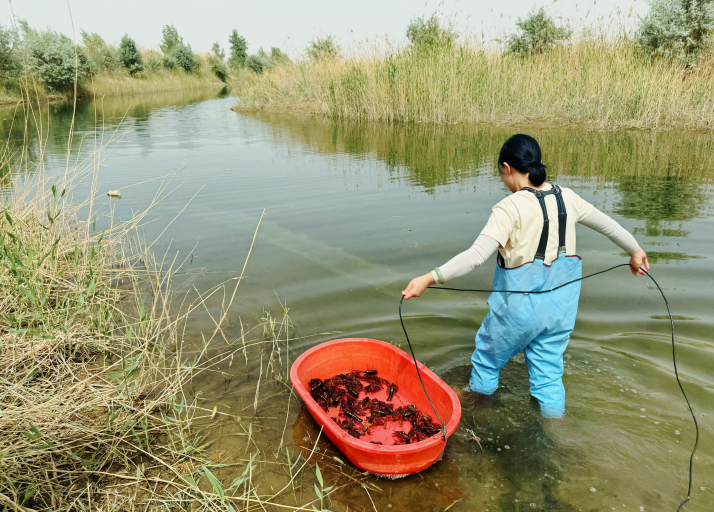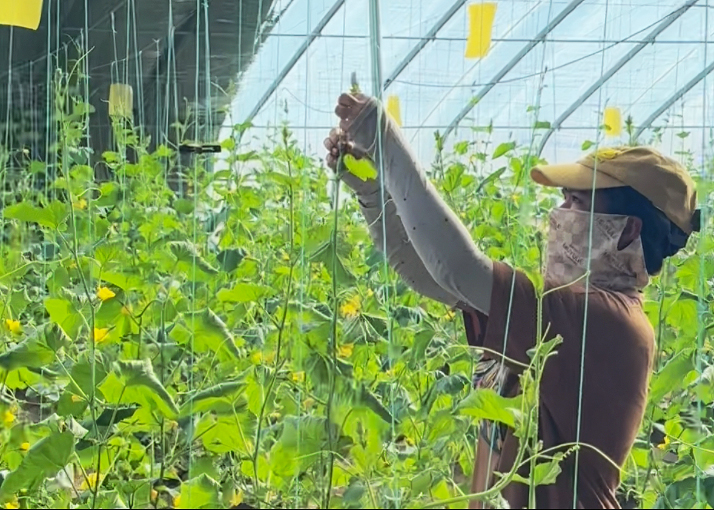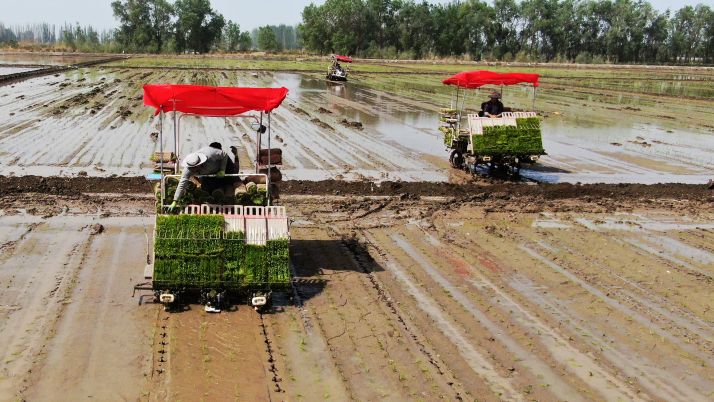| China |
| How Xinjiang amazes with its desert farming wonders | |
| Through human diligence and ingenuity, desert farming has been imbued with infinite imagination and possibilities | |
|
|
 Ma Chunhua harvests crayfish from a pond in Alaer, Xinjiang Uygur Autonomous Region, on May 22 (ZHANG SHASHA)
On an early summer morning, amid the shimmering green ripples and lush reeds of a pond in Alaer, Xinjiang Uygur Autonomous Region, "Crayfish Commander" Ma Chunhua was busy harvesting her crayfish to sell for the day. Seven years ago, the breeding stock for these crayfish were brought by Ma from Qianjiang, Hubei Province in central China, known as the country's hometown of crayfish, all the way to the northwestern region of Xinjiang. Alaer is located on the banks of the Tarim River, China's longest inland river, and adjacent to the Taklamakan Desert, the country's largest desert. Raising crayfish in desert regions was then a completely unheard-of concept for local people, but Ma sensed an opportunity. Once a local date farmer, she would often pass by these overlooked ponds with crystal-clear water on her way to the date farms. It was during her trips to other provinces that Ma by chance discovered the fervor surrounding crayfish—a culinary delight in high demand. Could she, she pondered, lease the ponds and venture into crayfish farming? Despite strong opposition from her family, Ma established a cooperative in August 2017 and purchased the first batch of crayfish fries from Qianjiang. Due to its distinct geographical and climatic conditions, soil salinization is common in Xinjiang, rendering the water saline and alkaline—a stark contrast to the acidic habitat to which the crayfish were accustomed. Together with the long and arduous transportation process, the survival rate of the migrant crayfish fries was extremely low, barely reaching 5 percent. "When the crayfish fries were introduced into the water, they were lively and energetic, but each day thereafter, we would find a layer of dead fries floating on the surface," Ma recalled. Ma felt a wave of despair wash over her. Just as she was on the brink of abandoning her investment, feeling as though her funds were being squandered, she was surprised to stumble upon some fry in the ponds. "It was truly exciting!" Ma said, "Having left them unattended without any feeding, they still managed to live and reproduce. It proves that they can survive the winter here in Xinjiang and even reproduce on their own." Seeing a glimmer of hope, Ma and the other members of the cooperative continued to expand their investment. Meanwhile, Ma dedicated herself to studying aquaculture techniques, implementing methods like planting aquatic vegetation to help the crayfish adapt to the new environment. In this way, the crayfish thrived in large numbers in their new home, and Ma became a recognized expert in crayfish farming. By the third year, they began to see profits, which steadily increased. Now, their farming base has expanded to 33.3 hectares, with an annual yield of 2.25 tons per hectare. The cooperative has established long-term partnerships with restaurants and seafood shops across Xinjiang and has promoted crayfish farming in the surrounding areas by selling crayfish fries and providing technical guidance. The number of cooperative members has grown from the initial five to 10, with each member seeing an annual income increase of about 50,000 yuan ($6,900). Participating in the initiative has also boosted the income of neighboring farmers. Cultivating crayfish in the desert might be one of the most striking innovations in Xinjiang's dryland farming, but it is far from the only one. In the enigmatic and enchanting region, nothing seems impossible. In the vast deserts of south Xinjiang, where drought and scant rainfall pose challenges to human agricultural endeavors, nature has also bestowed unique blessings upon the land. Through human diligence and ingenuity, desert farming has been imbued with infinite imagination and possibilities. This synergy has unleashed enormous potential within the desert.  A local farmer works inside a greenhouse in Kalpin County of Aksu Prefecture, Xinjiang Uygur Autonomous Region, on May 21 (ZHANG SHASHA)
The desert blooms In the Gobi Desert, about 2 km away from the urban area of Kalpin County in Xinjiang's Aksu Prefecture, stand more than 200 neatly arranged glass greenhouses. This is one of the county's leading agricultural industrial parks. Upon entering the greenhouses, visitors are greeted by flourishing vegetables and a warm, humid environment. The vibrant greenery inside makes it easy to forget about the stones, gravel, aridity, and strong winds outside. The cultivation of vegetables in the Gobi Desert, where not even a blade of grass grows naturally, is yet another spectacle of this new desert farming. "Kalpin has limited arable land per capita, but it boasts vast expanses of the Gobi Desert," Tang Yunquan, Director of the Rural Revitalization Bureau of Kalpin, told Beijing Review. He said the cultivation of agricultural products in specialized facilities in the Gobi Desert does not occupy arable land and allows for the maximum utilization of the region's resources, thus reducing land use costs. Greenhouses can also contribute to overcoming local agricultural bottlenecks, such as soil salinization and water scarcity, while fully leveraging local advantages such as sunlight and temperature, Tang added. In recent years, the local authorities have implemented policies focusing on attracting investment to develop facility cultivation agriculture, unlocking the potential of desert resources. In 2021, Wang Konghui, manager of the industrial park, came to Kalpin from China's vegetable capital, Shouguang in the eastern province of Shandong. With extensive farming experience, he tackled soil salinization by utilizing river sand as a medium and using fertilizer judiciously. He also addressed water scarcity concerns by implementing advanced drip irrigation systems, ultimately yielding high-quality fruit and vegetables. "We were primarily attracted to the high selenium content and alkalinity of the local water, as these factors contribute to higher vegetable quality and are beneficial to human health. The lower labor costs were also appealing," Wang said. To date, the total investment in the industrial park has reached 180 million yuan ($24.8 million), with government subsidies totaling 5.3 million yuan ($731,100). The cultivated area spans over 26.7 hectares, yielding approximately 6,000 tons of fruit and vegetables annually, with a total output value of around 150 million yuan ($20.7 million). The initiative has also facilitated stable employment for over 300 locals. In the future, Wang plans to intensify efforts in livestreaming sales and to transform the area into a comprehensive venue integrating growing, processing, picking as a form of tourism and leisure entertainment. "This initiative has brought about remarkable economic and social benefits. It has not only addressed the issue of local residents struggling with expensive and scarce vegetables, but has also empowered them with newfound vegetable cultivation techniques, potentially reshaping their dietary habits," Tang said.  Workers plant seedlings at a rice-growing facility in Alaer on May 15 (WANG CHENG)
The blessing in disguise The sharpness of a sword is honed by grinding, and the fragrance of plum blossoms comes from enduring the bitter cold. Yang Jun, general manager of a prominent rice production company in Alaer, applied this Chinese poem in describing his rice—yangzhizi rice—named after a distinctive white jade, which is called mutton-fat jade (yangzhiyu in Chinese), found in Xinjiang, owing to its resemblance. This poem aptly characterizes his rice because it flourishes in unfavorable conditions near the edge of the Taklamakan Desert, known as the "Sea of Death." It is precisely this challenging environment that allows the rice to thrive in Xinjiang, even surpassing its quality in its original growing region of Yunnan Province in southwest China. This remarkable phenomenon stands as yet another marvel of desert farming. "The water, soil, and environmental conditions for growing rice in Xinjiang are less suitable than those in Yunnan," Yang told Beijing Review. "For instance, rice prefers acidic soil and water, while those in south Xinjiang are alkaline. Additionally, the climate is more arid in Xinjiang." These external factors trigger secondary metabolic reactions in the rice, which are responses that plants produce to cope with unfavorable environmental conditions. These reactions, paradoxically, improve the aroma and quality of the rice and stimulate the production of functional nutrients, he explained. This is also the primary reason why Xinjiang's agricultural products are so delicious, he added. Though nature is generous with the blessings it bestows on desert agriculture, it disguises them as challenges. Yang said the abundant sunshine in the region means longer days with higher daytime temperatures and higher temperatures overall, compared to other regions. With less precipitation and colder winters, there are fewer pests and diseases, reducing the need for pesticides. The reduced residue from the heavy metals in pesticides makes rice produced in the region safer. Additionally, the snowmelt from the local mountain ranges is rich in selenium and strontium, enhancing the health benefits of the rice. These factors have propelled this type of rice to prominence in various international competitions, gaining international acclaim and establishing it as one of the signature rice products of China. Since the successful trial planting of rice in Xinjiang in 2016, the establishment of the company in 2019, and the sale of 15,000 tons of rice worth more than 36 million yuan ($4.97 million) in 2023, the desert has borne witness to a remarkable transformation from a single good seed to the production of high-quality rice. Yang's company is further expanding its investment by constructing high-standard grain storage facilities, capitalizing on the market potential of premium rice as well as recognizing the boundless potential of desert farming. BR (Print Edition: Sowing Imagination In the Sands) Copyedited by G.P. Wilson Comments to zhangshsh@cicgamericas.com |
|
||||||||||||||||||||||||||||
|